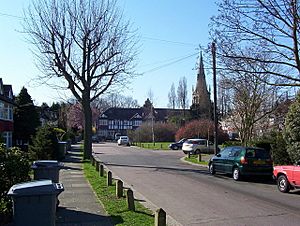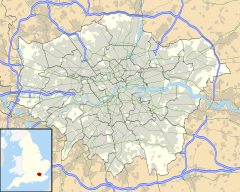Kingsbury facts for kids
Quick facts for kids Kingsbury |
|
|---|---|
 St Andrews Road and Church, Kingsbury |
|
| Area | 5.63 km2 (2.17 sq mi) |
| Population | 29,217 |
| • Density | 5,190/km2 (13,400/sq mi) |
| OS grid reference | TQ195885 |
| London borough | |
| Ceremonial county | Greater London |
| Region | |
| Country | England |
| Sovereign state | United Kingdom |
| Post town | LONDON |
| Postcode district | NW9 |
| Dialling code | 020 |
| Police | Metropolitan |
| Fire | London |
| Ambulance | London |
| EU Parliament | London |
| UK Parliament |
|
| London Assembly |
|
Kingsbury is a lively district in northwest London, part of the London Borough of Brent. Its name, Kingsbury, means "The King's Manor," which tells us it was once a special place owned by a king. In the past, Kingsbury was a bigger area, including places like Queensbury, Kenton, and Wembley Park. Today, Kingsbury is mainly covered by the Fryent and Barnhill wards, which are like local neighborhoods for voting and services. A large part of Kingsbury, about a quarter of it, is taken up by the beautiful Fryent Country Park. Kingsbury has a mix of buildings, from tall high-rises to quiet suburban homes, and even wild green spaces in the country park.
Contents
Kingsbury's Past: A Look at Its History
Kingsbury used to be a small, rural area in Middlesex county, covering about 6.9 square kilometers. It was much quieter and more spread out than it is today.
Early Beginnings and Royal Connections
Long before the Norman Conquest in 1066, early English kings no longer owned the manor of Kingsbury. An estate called Tunworth, in the northern part of Kingsbury, was given to a nobleman named Lyfing in 957. By 1066, this estate was likely part of the Kingsbury manor. This manor was later owned by Ernulf of Hesdin. Over time, the ownership of Kingsbury manor passed down through different families.
Growth and Development in Kingsbury
Kingsbury didn't grow much in the 1800s. It remained a collection of small villages rather than a single large town. During this time, Oliver Goldsmith, a famous writer, lived at Hyde Farm in Kingsbury from 1771 to 1774.
Even though it was close to London, Kingsbury developed slowly. A lot of building and population growth happened after World War I. An aircraft industry started near Hendon Aerodrome during the war. Roads were also improved for the British Empire Exhibition held in nearby Wembley in 1924. The number of homes in Kingsbury jumped from just 140 in 1901 to nearly 4,000 in 1931. By 1951, there were almost 12,000 homes! Between 1921 and 1931, Kingsbury's population grew by a huge 796%.
Famous Inventions and Local Businesses
Did you know that John Logie Baird, who invented television, sent his experimental TV signals from Kingsbury Manor? This was from the stable block, which is now the Veterans Club in Roe Green Park.
From 1923 to 1979, Kingsbury Road was home to Vanden Plas, a company that made special car bodies for famous brands like Bentley. This site is now the Kingsbury Trading Estate.
Changes in Local Government
In 1894, Kingsbury became part of the Wembley urban district. However, Kingsbury's local councillors felt their area wasn't getting enough attention. So, in 1900, Kingsbury became its own separate urban district with its own council. This new council faced some challenges, but it worked to serve the area.
In 1934, the Kingsbury Urban District merged back into the Wembley Urban District. Wembley later became a municipal borough in 1937. Finally, in 1965, Kingsbury became part of the larger London Borough of Brent, which it is today.
Community and Faith
A Jewish community group started in Kingsbury in 1939. In 1942, a place called Eden Lodge at Kingsbury Green was registered for worship, and it became the Kingsbury district synagogue in 1954.
Who Lives in Kingsbury: Demographics
The 2011 census showed that in the Fryent ward of Kingsbury, the largest ethnic group was Indian, making up 21% of residents. White people made up 37% in total, including British, other White groups, and Irish. About 11% were from other Asian backgrounds. In terms of religion, 41% were Christian, 21% Muslim, and 20% Hindu.
Kingsbury in Pop Culture
Kingsbury has appeared in popular culture! The first two seasons of the BBC children's TV show Grange Hill were filmed at Kingsbury High School. Also, the music video for Round Here by George Michael, which is about his childhood, features places like Roe Green Park and Roe Green Primary School.
Kingsbury's Location: Geography
Neighbouring Areas Around Kingsbury
 |
Canons Park | Queensbury | Colindale |  |
| Kenton | Hendon | |||
| Preston | Wembley Park | Welsh Harp |
Getting Around Kingsbury: Transport
Main Roads
Kingsbury Road (A4006) is the biggest road that runs through the district.
Bus Services in Kingsbury
Many London Buses routes serve Kingsbury, connecting it to other parts of London:
| Route | Start | End | Operator |
| 79 | Alperton Sainsburys | Edgware | Metroline |
| 83 | Ealing Hospital | Golders Green | Metroline |
| 183 | Pinner | Golders Green | London Sovereign |
| 204 | Sudbury | Edgware | Metroline |
| 302 | Mill Hill Broadway | Kensal Rise | Metroline |
| 305 | Kingsbury Circle | Edgware | Arriva Shires & Essex |
| 324 | Brent Cross Tesco | Stanmore | London Sovereign |
| 628 | Southgate | Kingsbury JFS | Sullivan Buses |
| 653 | Muswell Hill | Kingsbury JFS | Sullivan Buses |
| 683 | Friern Barnet | Kingsbury JFS | Sullivan Buses |
| 688 | Kingsbury JFS | Southgate | Sullivan Buses |
| N98 | Holborn | Stanmore | Metroline |
Tube Stations
The main underground station in the area is:
- Kingsbury Station (on the Jubilee line)
Green Spaces: Local Parks
Kingsbury has several lovely parks and open spaces for everyone to enjoy:
- Barn Hill Open Space
- Fryent Country Park
- Kingsbury Green Recreation Ground
- Roe Green Park
- Silver Jubilee Park
- Grove Park Open Space
See also
 In Spanish: Kingsbury para niños
In Spanish: Kingsbury para niños


